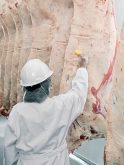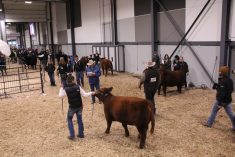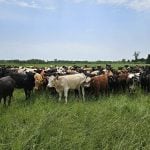Fed cattle
A larger domestic slaughter supply coupled with heavier carcass weights limited seasonal improvement in the fed market. The fed steer average in mid-March was $149.93/cwt, $0.98/cwt lower than the start of the month and down $2.65/cwt when compared to a year ago. Mid-March 2020 was the start of the market disruptions due to the COVID-19 pandemic and year-over-year comparisons will begin to show that in the coming weeks.
However, feedlot losses continue and cattle are being pulled ahead as cost of gain is encouraging fewer days on feed. In addition, set-aside-program cattle are still entering the slaughter mix. Fortunately, strong domestic and export beef demand has continued, retail beef sales are strong and food service sales are increasing. The Canadian basis is very strong, currently at +$7.67/cwt over the U.S. Fortunately, this is the case as feedlot margins are slim and the historical five-year average cash-to-cash basis is -$6.78/cwt.
Read Also

Body condition, nutrition and vaccination for brood cows
One of the remarkable events of the past century related to ranching has been the genetic evolution of brood cows….
Cattle on feed in Alberta and Saskatchewan on March 1 totalled 1,004,254 head, down seven per cent from a year ago. Fewer feeder cattle exports plus feeder imports meant larger placements through February. Placements were up 19 per cent to total 145,243 head. Fed production to date in 2021 was 17 per cent above a year ago, resulting from a 10 per cent increase in fed steer slaughter and a 23 per cent increase in fed heifer slaughter. Carcass weights are still well above year-ago levels.
Exports of fed cattle, including cows, are seven per cent below a year ago, at just 81,624 head reported in the first two months of 2021.
Deb’s outlook for fed cattle: Typically, spring highs are realized between late March and mid-April as grilling season approaches. Domestic and export demand remain strong, which will support the fed market. In the coming weeks more cattle that were placed in the set-aside program will become available, limiting upside potential in the near term. However, supplies should remain manageable as feedlots have been pulling cattle forward throughout much of the first quarter.
Deferred live cattle futures continue to trade at a premium to the near months, which is uncommon. However, supply fundamentals and demand suggest limited seasonal strength as we move into the second quarter. The market will be affected whether COVID-19 restrictions are lifted, or if case numbers surge and restrictions are added.
Feeder cattle
Despite high feed grain prices and negative feedlot margins, feeder cattle prices have remained relatively solid. Five-hundred-and-fifty-pound steers have seen a trading range of $232-$233/cwt recently, with a quick jump to $236/cwt noted in late February. The mid-March weekly average was $232.28/cwt. That is $1.57/cwt higher than the March 13, 2020 average, which was just before prices fell due to the COVID-19 pandemic.
Grain prices continue to increase breakeven costs for buyers, although the effect hasn’t been seen as much as expected in the feeder market. Barley prices in mid-March were 38 per cent higher than one year earlier. Heavier feeders have felt the impact of the lackluster fed cattle prices. The 850-lb. feeder price average dropped $3.57/cwt over two weeks, hitting $178.57/cwt in mid-March. This is $8.23/cwt below the same week in 2020.
The 850-lb. feeder basis is strong at $8.98/cwt. This compares to last year when the basis was -$5.09/cwt and the five-year average at -$11.24/cwt. Feeder exports are 49 per cent lower through the first two months of 2021, at a total of just 9,184 head.
Deb’s outlook for feeder cattle: Demand for grasser-type cattle will pick up in coming weeks as pastures turn green and buyers look to fill orders. Heavier cattle will likely trend sideways in the near term, as poor fed cattle margins and high cost of gain limit the upside on shorter-keep cattle.
A smaller supply of feeder cattle is supportive to the feeder market. Cattle inventory reports confirm continued herd contraction in North America, meaning a smaller calf crop again in 2021. Working against the feeder market are high feed costs. In addition, the Canadian dollar has seen a steady incline.
Non-fed cattle
Cull cows have finally seen the upward movement that we typically expect early in the first quarter. The D1,2 cow price in Alberta increased $11.92/cwt from the low seen in January to a mid-March average of $86/cwt, just $0.29/cwt under the same week last year. However, the D1,2 market is still trailing the five-year average for mid-March, which is $7/cwt higher at $93/cwt. The cull bull market has also improved. At $104.79/cwt in mid-March, it was slightly higher than last year’s $104.35/cwt the same trading week.
As packing plants have focused on managing fed cattle supplies, domestic cull cow slaughter is down 11 per cent. As of March 6, 2021, the number of cows killed was at 84,964 head. Additional feed stocks and lower cull prices resulted in cow-calf producers marketing fewer cows through the winter. Bull slaughter has been higher than a year ago, up 16 per cent to 2,257 head in early March. However, slaughter bull exports were down 17 per cent, totalling 4,070 head.
Deb’s outlook for non-fed cattle: Warmer weather and the approaching grilling season will support the cull market. Retail demand for grinding and trim meat has been solid and should remain strong. Cow supply will tighten as most commercial operations are busy calving and many fall-purchased feeder cows have already moved through the system. Look for seasonal strength moving through the start of the second quarter for cow prices.
















